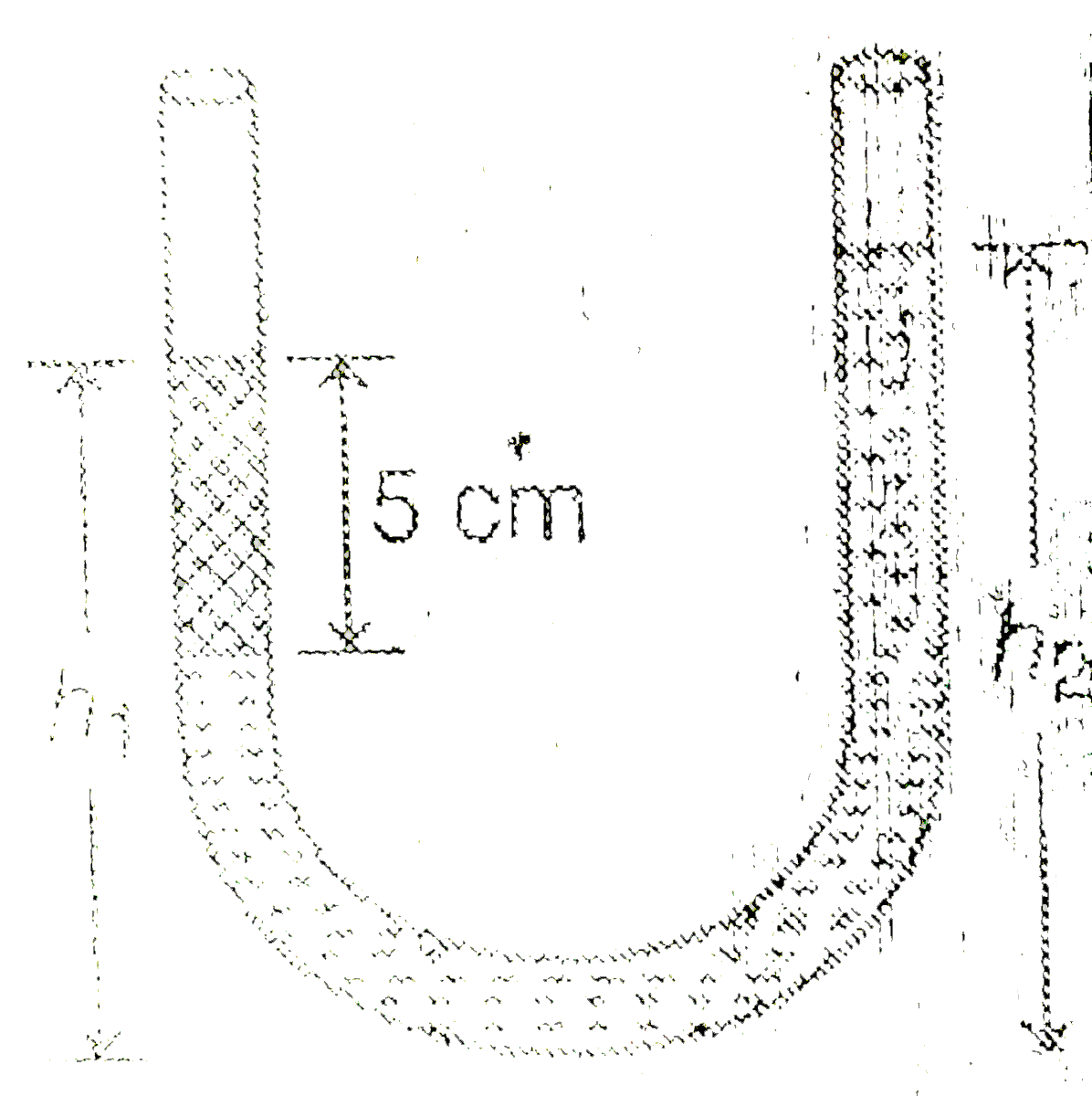A vertical U-tube of uniform cross-section contains mercury in both its arms. A glycerine (density = 1.3g⋅cm−3) column of height 10 cm is introduced into one of the arms. Oil of density 0.8g⋅cm−3 is poured into the other arm until the upper surfaces of oil and glycerine are at the same level. Find the height of the oil column. The density of mercury is 13.6g⋅cm−3.
Let the height of the oil column be h

According to the figure, AC = ED
or, h + BC = 10
or, BC = (10 - h)cm
Now, pressure at the point C = pressure at the point D
or, h×0.8×g+(10−h)×13.6×g=10×1.3×g
or, h×0.8+136−13.6h=13
or, 12.8h = 123
or, h=12312.8=9.61cm.
Topper's Solved these Questions
- HYDROSTATICSBOOK - CHHAYA PUBLICATIONCHAPTER - HYDROSTATICSEXERCISE - SECTION RELATED QUESTIONS
12 Videos
- HYDROSTATICSBOOK - CHHAYA PUBLICATIONCHAPTER - HYDROSTATICSEXERCISE - HIGHER ORDER THINKING SKILL (HOTS) QUESTIONS
37 Videos
- FRICTION BOOK - CHHAYA PUBLICATIONCHAPTER - FRICTION EXERCISE - CBSE SCANNER
7 Videos
- KINETIC THEORY OF GASESBOOK - CHHAYA PUBLICATIONCHAPTER - KINETIC THEORY OF GASESEXERCISE - CBSE Scanner
9 Videos
Similar Questions
A vertical U tube of uniform cross section contains mercury in both of its arms. A glycerine (d=1.3g/cm3) column of length 10cm is introduced into one of the arms. Oil of density 0.8g/cm3 is poured in the other arm until the upper surfaces of the oil and glycerine are in the same horizontal level. Find the length of oil column. Densit of mercury is 13.6g/cm3.

View SolutionA vertical U-tube of uniform inner cross-section contains mercury in both of its arms. A glycerine (density1.3gcm−3) column of length 10cmis introduced into one of the arms Oil of density 0.8gcm−3 is poured in the other arm until the upper surface of the oil and glycerine are in the same horizontal level. Find the length of the oil column.
View Solution_S01_015_Q01.png)
A vertical U-tube of uniform cross-section contains mercury in both arms A glycerine (relative density =1.3) column of length 10 cm is introduced into one of the arms. Oil of density 800 gm m−3 is poured into the other arm until the upper surface of the oil and hlycerine are at the same horizontal level, find the length of the column. Density of mercury is 13.6×103kgm−3
View Solution_S01_015_Q01.png)
A vertical U-tube of uniform cross-section contains mercury in both arms A glycerine (relative density =1.3) column of length 10 cm is introduced into one of the arms. Oil of density 800 gm m−3 is poured into the other arm until the upper surface of the oil and hlycerine are at the same horizontal level, find the length of the column. Density of mercury is 13.6×103kgm−3
View SolutionA vertical U-tube of uniform inner cross section contains mercury in both sides of its arms. A glycerin (density =1.3g/cm3) column of length 10 cm is introduced into one of its arms. Oil of density 0.8 gm/cm3 is poured into the other arm until the upper surfaces of the oil and glycerin are in the same horizontal level. Find the length of the same horizontal level. Find the length of the oil column, Density of mercury =13.6g/cm3

View SolutionThe arms of a vertical U tube of uniform inner cross section contains mercury. In one of the arms of the tube, water column of length 8 cm is introduced. In the other arm, oil of density 0.75 g/cm3 is poured till the upper surfaces of water and oil are at same horizontal level. Calculate the length of oilcolumn.
View SolutionThe height of mercury which exerts the same pressure as 20 cm of water column, is
View SolutionA U-tube contains water in its lower part. Then 32 cm of kerosene of relative density 0.8 is poured into one limb and a vegetable oil of reative density 0.65 is poured into the other. The water level in the kerosene oil side is 5 cm lower that in the other . what is the height of the column of vegtable oil ?\
View SolutionCalculate the height of a water column which will exert on its base the same pressure as the 70 cm column of mercury. Density of mercury is 13.6g cm−3
View SolutionAn open -ended U-tube of uniform cross-sectional area contains water (density 1.0g/cm23) standing initially 20 cm from the bottom in each arm. An immiscible liquid of density 4.0g/cm2 is added to one arm until a layer 5 cm high forms, as shown in the figure above. What is the ratio h2/h1 of the heights of the liquid in the two arms ?

View Solution
